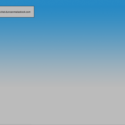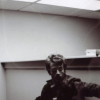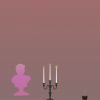7 Question Interview with Duncan Malashock, Brooklyn-based Artist and Filmmaker

Duncan Malashock is a Brooklyn-based artist and filmmaker whose work we have featured before — that being his 2006 piece, Road, and Pyramid (2008). His work was featured in the recent REFRESH exhibit at the AXIOM Center for New and Experimental Media. Duncan makes “analog videos that are concerned with the history of creative technology.” He also makes interactive websites and recently started making sculptural pieces using projections. Duncan was born 1982, San Diego, southern California, and graduated Bard College 2005, BA Integrated Arts.
(1) What do you make and what aesthetics do you pursue?
 I’m interested in our relationship with technology, specifically within the context of the Internet as a day-to-day activity, and in light of the history of the use of technology as a way of representing ideals. I make analog videos that are concerned with the history of creative technology, and in exploring what I understand as the ideals of early computer art. I also make interactive websites as public artwork, and that work emphasizes exploring interaction and simulations as their own media. Lately I’ve also started making sculptural pieces using projections, either from laser light or digital projector, which explore both of these sets of ideas, with a focus on the interaction between the “immaterial” content and physical spaces and objects.
I’m interested in our relationship with technology, specifically within the context of the Internet as a day-to-day activity, and in light of the history of the use of technology as a way of representing ideals. I make analog videos that are concerned with the history of creative technology, and in exploring what I understand as the ideals of early computer art. I also make interactive websites as public artwork, and that work emphasizes exploring interaction and simulations as their own media. Lately I’ve also started making sculptural pieces using projections, either from laser light or digital projector, which explore both of these sets of ideas, with a focus on the interaction between the “immaterial” content and physical spaces and objects.
Temple
Digital video, 2009
(2) Your thirst for inspiration: what is something you love, but can not get enough of? Does your thirst for this inspire and guide your art; how does your work correspond with its influences?
 I think most of my interests come from my background. I’m from Southern California, so that’s probably why I’m obsessed with ideas like self-created identity, lifestyle marketing, and the possibilities of technology, our understanding of which has largely been shaped by the Californian intersection of phenomena like the Human Potential Movement and Silicon Valley. My dad is a modern dance choreographer, so that’s probably why I’m interested in the expressive qualities of motion and physical performance, both of which are involved a lot, both actively and latently in my work. Simulations come up a lot in my work as a way of exploring these interests. Sometimes an interactive or static simulation of an object or process will form the basis for a new piece. I’m always reading when I’m working on something, and often times that manifests itself in the form of subjects or titles for pieces.
I think most of my interests come from my background. I’m from Southern California, so that’s probably why I’m obsessed with ideas like self-created identity, lifestyle marketing, and the possibilities of technology, our understanding of which has largely been shaped by the Californian intersection of phenomena like the Human Potential Movement and Silicon Valley. My dad is a modern dance choreographer, so that’s probably why I’m interested in the expressive qualities of motion and physical performance, both of which are involved a lot, both actively and latently in my work. Simulations come up a lot in my work as a way of exploring these interests. Sometimes an interactive or static simulation of an object or process will form the basis for a new piece. I’m always reading when I’m working on something, and often times that manifests itself in the form of subjects or titles for pieces.
Group Drawing
Digital video, 2010
(3) How do you use your hands to make stuff; how do you use your
computer to make stuff?
A lot of my work is made with systems or simulations, either by using or creating very rigid systems and attempting to be expressive within their constraints, or attempting to create interactive systems which respond expressively to a user’s actions. So the nature of a lot of the work is either in controlling parameters, usually by changing numbers by very small amounts, or interacting expressively with an interface, usually by dragging the mouse around.
http://www.pilewithpedestal.com
Animated interactive website in domain name, 2010
(4) Art and work; the work in art; the process of creating: what
parts of the process are laborious?
 Sometimes a website piece will involve weeks of writing and debugging code; other times I’ll steal someone else’s code and change something minor. Sometimes I’ll work on a system for making work within, which may end up taking months to do, and the pieces I make using it will take a few hours or minutes to finish. Sometimes I’ll work with a very specific end result in mind, but at the last minute I’ll make a mistake and like it, and that will be what finishes the piece. The nature of the actual work involved goes back and forth between the head and hands; when it’s not architectural or design-oriented, it’s very physical and direct.
Sometimes a website piece will involve weeks of writing and debugging code; other times I’ll steal someone else’s code and change something minor. Sometimes I’ll work on a system for making work within, which may end up taking months to do, and the pieces I make using it will take a few hours or minutes to finish. Sometimes I’ll work with a very specific end result in mind, but at the last minute I’ll make a mistake and like it, and that will be what finishes the piece. The nature of the actual work involved goes back and forth between the head and hands; when it’s not architectural or design-oriented, it’s very physical and direct.
http://www.letsmakesureeverythingisathing.com
Animated interactive website in domain name, 2010
(5) How do you wish to expand your work?
I started publicly interactive artwork on the Internet to make my work more accessible, but as I kept using it I started to appreciate the Internet as its own context, one with very interesting and problematic qualities, not only where presentation and distribution of artwork is concerned, but also with regard to the social aspect of making work online. How is culture evaluated after the Internet? How can an Internet-based artwork be shown effectively within a gallery setting? What is the nature of online work as a commodity? What is the nature of the online art “community”? All of these questions contain directions for expanding work that are all very interesting to me.
Computer-Generated Ballet by Michael Noll, 1963
(6) Is the internet really cool, or cool?
The Internet’s great. I used to be the only artsy computer geek I knew; now I’m a part of multiple groups of them. The Internet as an explosion of points of view seems like just what we needed to put the whole postmodern revolution into the global perspective it was asking for; but now what concerns me is the task of balancing all that cultural material with traditions, and not letting the speed of information obscure our history.
(7) Is there something new you wish to pursue?
I started a project called chat.duncanmalashock.com, which is a kind of library of online chat transcripts as art writing. I think there are a lot of possibilities that open up when people become casual with their ideas and how they present them, and it was also about getting more involved with people in the online artwork community. My experiences with in online artwork got me interested in pursuing the possibilities of continuity in that group, possibilities which are difficult to achieve given how quickly information is consumed and replaced online. I’m interested in how that stream of information can transform into a culture, one that is perhaps more stable and aware of its history and community.
////////////////////////////// _______ _______ _______ |\ /|\ /|\ /| | +---+ | +---+ | +---+ | | | | | | | | | | | | |E | | |N | | |D | | | +---+ | +---+ | +---+ | |/_____\|/_____\|/_____\| //////////////////////////////
More:




1 Trackback or Pingback